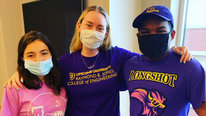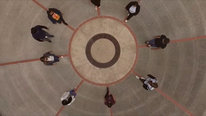- Nichole Spencer
- Title V Project Director
- Building Capacity: Integrating Research, Mentoring, and Industry Collaborations to Improve STEM Recruitment and Retention
- https://sites.google.com/phoenixcollege.edu/mcccdstemcure/home
- Phoenix College
- Rosalind Cook
- STEM-CURE Grant Coordinator
- Building Capacity: Integrating Research, Mentoring, and Industry Collaborations to Improve STEM Recruitment and Retention
- https://sites.google.com/phoenixcollege.edu/mcccdstemcure/home
- Phoenix College
- Robin Cotter
- Professor
- Building Capacity: Integrating Research, Mentoring, and Industry Collaborations to Improve STEM Recruitment and Retention
- https://sites.google.com/phoenixcollege.edu/mcccdstemcure/home
- Phoenix College
- Anna Marti-Subirana
- Professor
- Building Capacity: Integrating Research, Mentoring, and Industry Collaborations to Improve STEM Recruitment and Retention
- https://sites.google.com/phoenixcollege.edu/mcccdstemcure/home
- Phoenix College
- Elena Ortiz
- Professor
- Building Capacity: Integrating Research, Mentoring, and Industry Collaborations to Improve STEM Recruitment and Retention
- https://sites.google.com/phoenixcollege.edu/mcccdstemcure/home
- Phoenix College
Public Discussion
Continue the discussion of this presentation on the Multiplex. Go to Multiplex











Rosalind Cook
STEM-CURE Grant Coordinator
Welcome to our video page.
We are using CUREs (Course-based Undergraduate Research Experiences) to bring research experiences to a whole classroom at a time at our community college. And we have continued to run most of these classes despite the challenge of teaching on-line thanks to COVID.
Are you interested in trying a CURE in your classroom? Have you done something similar at a community college?
We'd love your questions, ideas, or any feedback. Thank you!
Vedham Karpakakunjaram
Robin Cotter
Mesut Duran
Professor of Technology
Hi Rosalind: Among others, I liked the focus on community college students. Is a possible longitudinal study part of the thinking to follow participating studies through the four-year college experience and perhaps beyond? Thanks, Mesut
Robin Cotter
Professor
That is a great suggestion! We are currently tracking transfer to 4-year institutions and occupational programs such as nursing.
Mesut Duran
Professor of Technology
Excellent!
Jillian Miller
This is phenomenal! I have been interested in incorporating undergraduate research at our community college and this opens up a world of possibilities!
Anna Marti-Subirana
Professor
Thanks for your comment. Please feel free to contact us!
If you would like to know more about the program, please visit the STEM-CURE Program Website:
https://sites.google.com/phoenixcollege.edu/mcc...
Anna Marti-Subirana
Professor
Jillian, I was watching your video just a few minutes before you posted your comment. Joining the network!
Alexa Sawa
Hi fellow CC faculty! I am not too far from you in Palm Desert CA. Kudos on bringing these valuable experiences to your students. I am curious about what course(s) you implement your CURE in. It can be so hard to find space in these high unit majors. I use a genomics CURE in my Molecular and Cell Biology class. This means there are some other more traditional labs that we skip, but I think the tradeoff is worth it.
Elena Ortiz
Professor
Hi Alexa,
I've been doing a CURE with my non-majors biology course and a fellow faculty implemented his in a statistics course (non-math majors). We also have a first semester bio majors course that is doing a CURE. And a microbiology course. We try not to think about it as substituting content, but as teaching content with the CURE. It really helps make the content relevant to students. They can see real applications of what they are learning. Some are semester long projects and some are shorter. Feel free to reach out with any other questions anytime :-)
April Bartnick
Hi! This is such a neat project! It's so important to make science accessible and reach out to first-generation college students. Having mentors is such a great idea too! How do the CURE mentors get to be mentors?
Rosalind Cook
STEM-CURE Grant Coordinator
Thank you for checking out our project. I complete agree with what you said about making science and opportunities accessible for the first generation students -- in our case it's a mainly Hispanic student body too. Instructors get to choose their own mentors. Usually a student who has been in the class before and excelled. We have grant funding right now to pay them.
April Bartnick
Neela White
Project Director
Hi there! I truly enjoyed your video and learning about your project. It is great to hear what this project is doing for its students. I was intrigued by the CURE student mentor. How was she selected to serve as mentor. What is the ratio of mentor to students? Keep up the great work.
Robin Cotter
Professor
Thank you for taking time to learn about our project. Our student mentors are embedded into our CURE courses. They are often former students who have taken the class or who have participated in the CURE. They receive training through our student success specialist program and provide in-class support throughout the semester. As many of our CUREs are embedded into labs the ration can be anywhere from 1 student mentor to 12 or 24 students. The student mentors have been essential to the success of our CUREs and invaluable to our students especially when transitioning to the online environment due to the pandemic.
April Bartnick
Lisa Dierker
What a great program! CURE's are amazing experiences for students and for instructors they are so much more fun to teach than traditional lecture courses. It is wonderful to see these experiences provided early and often at you community college. Congratulation! Are there particular professional development you have provided to instructors or do you rely on instructors to find the training they need to offer CURE's? Our project has been doing professional development supporting instructors to learn leading statistical software tools in support of course-based research that requires data analytics (e.g., R, SAS, Stata, SPSS). Let us know if we can be helpful. passiondrivenstatistics.com
Kristin Flaming
Elena Ortiz
Professor
Thank you Lisa! We do a summer professional development and a year long mentorship for faculty to help them develop their CUREs. I will definitely be reaching out for help with professional development on statistics tools for faculty. I have been trying to retrain using R, and trying to incorporate more stats in my bio courses, but it is tough to do and keep up with COVID, course design, mentoring and teaching. Thanks for reaching out and posting!
Kristin Flaming
Hi Elena, I work with Lisa on the Passion-Driven Statistics grant. All our resources are free for students and faculty. Faculty resources are password protected so do reach out (kristin.flaming@gmail.com). We can share how we do our workshops to train faculty incorporating the model into their program. Our videos show step by step the software (R, SAS, STATA, Python, & SPSS) that many find helpful. We have found the free cloud based SAS easier for faculty and students to learn compared to R but we have many partners that use R in the classroom. I would be interested in learning how you run the summer pd as maybe there are aspects we should consider.
Robin Cotter
Elena Ortiz
Professor
Thank you Kristin, I just sent you an email :-)
Liz Diaz
Excellent initiative! It is great to see how students are learning while engaging in solve community problems.
Keep up the great work!
Robin Cotter
Elena Ortiz
Professor
Gracias Liz! I really enjoyed your video about finding ways to continue your great outreach work during this very difficult year too.
Alexander Rudolph
Professor of Physics and Astronomy
I am very intrigued by CUREs and would like to learn more about how you support faculty in developing them. Also, do you have any longitudinal data yet on whether students who participate in CUREs in community college do persist into a STEM major at a 4-year university?
Robin Cotter
Professor
Thank you for viewing our video! We currently provide faculty with stipends and mentors to help them design, implement and assess their CUREs. Interested faculty submit a CURE project proposal and once selected, attend a summer training academy where they collaborate with community partners, student mentors, and faculty mentors to further develop their projects. We are working with our institutional research office to track persistence and transfer data for students who participated in CUREs vs students in non-CURE courses. We are currently in year 3 of the grant so hope to have more transfer and persistence data by the end of year 5.
Jonee Wilson
Introducing STEM research experiences to undergrads is important work and it is particularly impressive that you all are doing this at a community college where students are often not provided such experiences! How do the students get trained to mentor other students? What types of opportunities are provided to support them in developing those skills?
Rosalind Cook
STEM-CURE Grant Coordinator
Hello Jonee, Thank you for being interested in our project. Our program hosts a short training workshop before the semester starts for both student mentors and professors --to set expectations. We continue to me meet with the students every 2 weeks during the semester to offer guidance and problem-solving sessions. We also give the new student mentors a chance to talk to the 'old' student mentors to hear about challenges and success. It's definitely a part of the project that we are hoping to deepen. Do you have any suggestions for us? We'd love some ideas.
Wonmai "Maia" Punksungka
Nichole, this is a nicely done video. I am glad that such a program like CUREs exist for community college STEM students. It's important that community college students have access to undergraduate research as this is such an important part of learning, but seems to be mostly available to 4-year universities and colleges.
Nichole Spencer
Title V Project Director
Thanks for watching Maia! We couldn't agree more. Not only do our students share great responses to their overall research experience (via CURE), but their confidence in STEM and engagement with 4-year universities while attending our community college is also increased. Win-win!